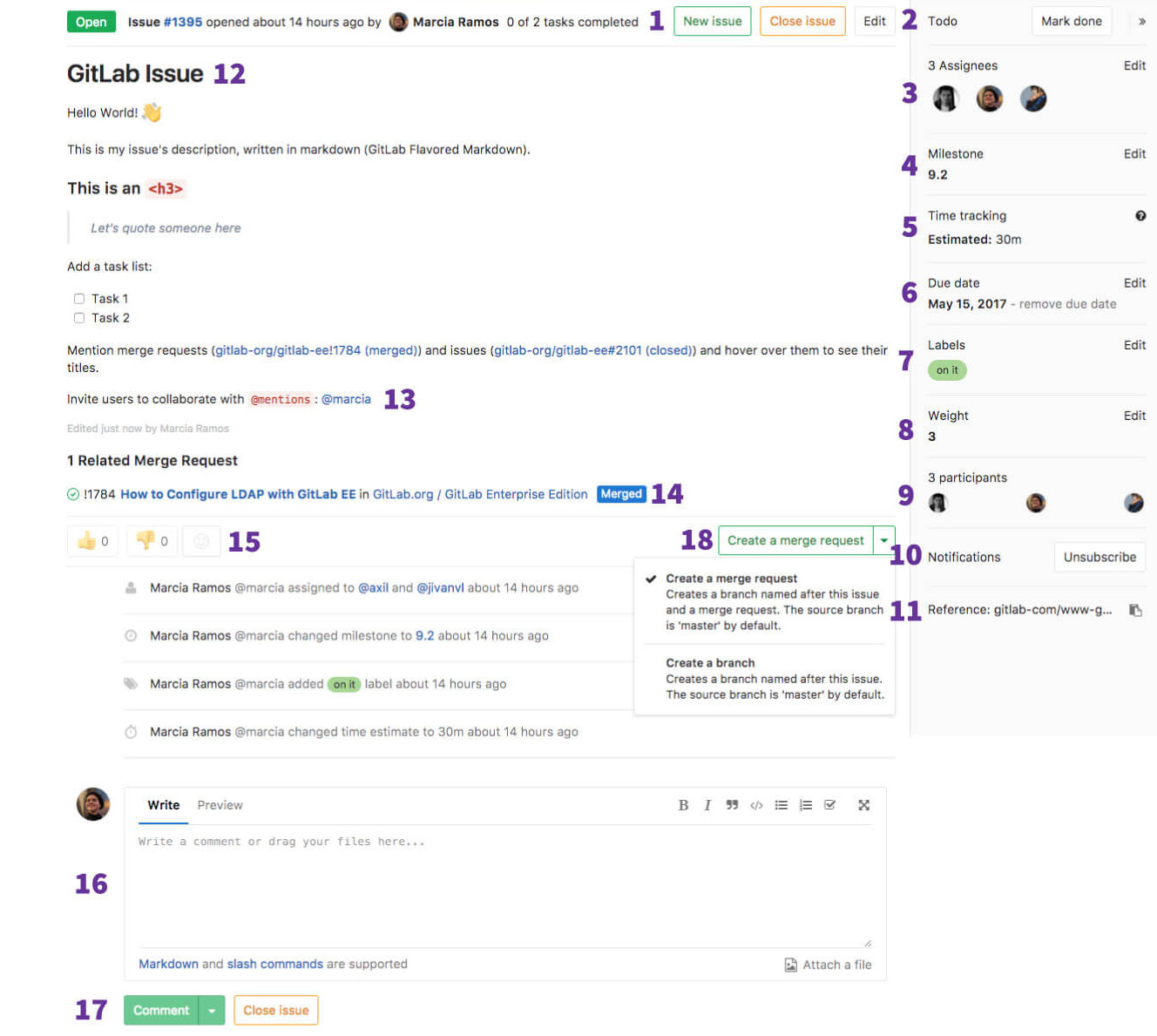GitLab Issues Functionalities
Please read through the GitLab Issue Documentation for an overview on GitLab Issues.
Issues Functionalities
The image below illustrates what an issue looks like:
You can find all the information on that issue on one screen.
Issue screen
An issue starts with its status (open or closed), followed by its author, and includes many other functionalities, numbered in the image above to explain what they mean, one by one.
Many of the elements of the issue screen refresh automatically, such as the title and description, when they are changed by another user. Comments and system notes also appear automatically in response to various actions and content updates.
1. New Issue, close issue, edit
- New issue: create a new issue in the same project
- Close issue: close this issue
- Edit: edit the same fields available when you create an issue.
2. Todos
- Add todo: add that issue to your GitLab Todo list
- Mark todo as done: mark that issue as done (reflects on the Todo list)
3. Assignee
Whenever someone starts to work on an issue, it can be assigned to that person. The assignee can be changed as much as needed. The idea is that the assignee is responsible for that issue until it's reassigned to someone else to take it from there.
Tip: if a user is not member of that project, it can only be assigned to them if they created the issue themselves.
3.1. Multiple Assignees [STARTER]
Often multiple people work on the same issue together, which can be especially difficult to track in large teams where there is shared ownership of an issue.
In GitLab Starter, you can assign multiple people to an issue.
Learn more in the Multiple Assignees documentation.
4. Milestone
- Select a milestone to attribute that issue to.
5. Time Tracking
- Estimate time: add an estimate of the time it will take to resolve the issue.
- Spend: add the time spent on the resolution of the issue
Note: Both estimate and spend times are set via GitLab Quick Actions.
Learn more in the Time Tracking documentation.
6. Due date
When you work on a tight schedule, it's important to have a way to set a deadline for implementations and for solving problems. This can be done in the due date element. Due dates can be changed as many times as needed.
7. Labels
Categorize issues by giving them labels. They help to organize workflows, and they enable you to work with the GitLab Issue Board.
Group Labels, which allow you to use the same labels for a group of projects, can be also given to issues. They work exactly the same, but they are immediately available to all projects in the group.
Tip: If a label doesn't exist yet, you can click Edit, and it opens a dropdown menu from which you can select Create new label.
8. Weight [STARTER]
- Assign a weight. Larger values are used to indicate more effort is required to complete the issue. Only positive values or zero are allowed.
Learn more in the Issue Weight documentation.
9. Participants
- People involved in that issue (mentioned in the description or in the discussion).
10. Notifications
- Subscribe: if you are not a participant of the discussion on that issue, but want to receive notifications on each new input, subscribe to it.
- Unsubscribe: if you are receiving notifications on that issue but no longer want to receive them, unsubscribe from it.
Read more in the notifications documentation.
11. Reference
- A quick "copy to clipboard" button for that issue's reference,
foo/bar#xxx, wherefoois theusernameorgroupname,baris theproject-name, andxxxis the issue number.
12. Title and description
- Title: a plain text title for describing the subject of the issue.
- Description: a large text field which fully supports GitLab Flavored Markdown, to describe all the details of the issue.
13. Mentions
- You can mention a user or a group present in your GitLab instance with
@usernameor@groupnameand they will be notified via todos and email, unless they have disabled all notifications in their profile settings. - Mentions for yourself (the current logged in user), will be highlighted in a different color, allowing you to easily see which comments involve you, helping you focus on them quickly.
To change your notification settings, navigate to Profile Settings > Notifications > Global notification level and choose your preference from the dropdown menu.
Tip: Avoid mentioning
@allin issues and merge requests, as it sends an email notification to all the members of that project's group, which can be interpreted as spam.
14. Related Merge Requests
- Any merge requests mentioned in that issue's description or in the issue discussion thread.
15. Award emoji
- Award an emoji to that issue.
Tip: Posting "+1" as a comment in a thread spams all subscribed participants of that issue. Awarding an emoji is a way to let them know you like it without spamming them.
16. Thread
- Comments: collaborate to that issue by posting comments in its thread. These text fields also fully support GitLab Flavored Markdown.
17. Comment, start a discussion, or comment and close
Once you write a comment, you can either:
- Click "Comment" and your comment will be published.
- Click "Start discussion": start a thread within that issue's thread to discuss specific points.
- Click "Comment and close issue": post your comment and close that issue in one click.
18. New Merge Request
- Create a new merge request (with a new source branch named after the issue) in one action. The merge request will automatically inherit the milestone and labels of the issue. The merge request will automatically close that issue when it is merged.
- Optionally, you can just create a new branch named after that issue.
